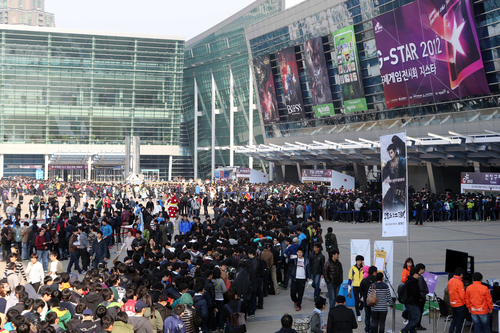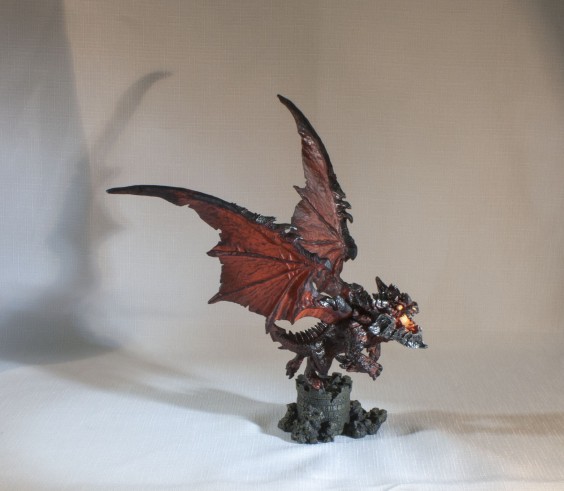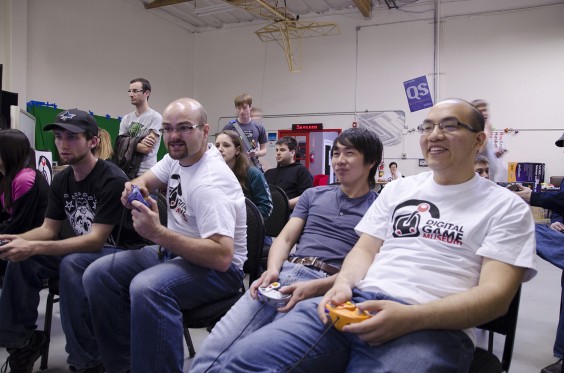December 2013 Newsletter
Written by Judith // November 29, 2013 // At the Museum, Newsletters // No comments
We Save Games
We’ve been using “We Save Games” as our tag line for a while now. It’s a play on saving progress in the game you’re playing and on the museum’s attempt to preserve gaming, but what does a museum really preserve in gaming? It’s not an easy question, and there are two possible interpretations of what’s important.
First we preserve consoles, arcade games, software – everything physical that you might play or play on. We do this knowing that digital files and media fail and become corrupted whether used or not, plastics degrade no matter what measures we take. Capacitors burst, colors fade. But we fight entropy with all the forces at our command and spend a big percentage of our budget doing so.
And there’s the second part of it; preserving game culture. Cultural anthropologists study community interactions: what happened around the campfire in pre-history cultures, religious rites, political machinations. And so we do our best to preserve what we can of what it feels like to be a gamer, to play a game, to be a game developer. It’s the ethnography of gaming.
We place high value on the bridge between the games and the culture. Game packaging – something that is becoming rare with Steam and the age of downloads – is a wonderful reflection of the times, from the silly stuff in Infocom gray boxes to the clever incorporation of copy protection as code wheels, un-copyable key sheets, and manuals full of clues. We love t-shirts, even though they pose a double problem of plastics (yes, those logos are plastic!) and textile conservation. I made an archaeologist laugh when I talked about keeping t-shirts in good condition for a few decades; archaeologists have to think in terms of centuries.
We’d be recording gameplay if we had a computer that could handle our Elgato game recorders, but our computers are limited, geared to showing vintage games at events. So we’re thankful for all the people who post their gameplay on YouTube – but how long will YouTube last? And when will a game company institute a take-down notice for the video that reveals a flaw or an Easter Egg? We take photos of our events that show people’s fun and delight in gaming, but how long will they last on Flickr? Yahoo has been in precarious straights before, and we know that no tech company is invulnerable (remember Silicon Graphics?). In fact, it’s possible to save more and more, but what will these records look like in 100 years? What will survive?
That’s where museums come in. We do our best to save some of all aspects of gaming, un-threatened by business failures, profitability decisions, fashions and marketability. Our success won’t be measurable for many years to come. But in the meantime, we rely on people like you who want our love for gaming to be conveyed to the next generation and the next so that people as yet unborn can see what delighted and entertained us, what we did with our friends, what taught us and what we made. So thanks for your support and encouragement – we’re all in this community together. You’re why we do this. You make it worthwhile.
Judith Haemmerle, Executive Director
Please support the Digital Game Museum and our mission of game preservation.
No PAX pass? Go to South Korea!
One of the biggest game conferences in the word happened this month. Most English speaking gamers aren’t aware of it because it’s an annual event held in Busan, South Korea. Why Busan? There was no venue in Seoul large enough to hold it . Why South Korea? Because South Korea is very important for gaming!
Odds are, you’ve played or thought about some games developed in South Korea. Or maybe you’ve watched some e-Sports and know who Lee Jae-Dong is. Or you’re marketing a game and know that the South Korean game market is worth about one billion dollars. Or you’re a cyber-security specialist and are following the allegations that North Korea embedded a virus in a downloadable game. And of course, G-STAR; last year G-STAR (Game Show & Trade, All Round) had 190,353 unique visitors (296,169 counting duplicates), 434 companies from 31 countries at 2,111 booths, reported 3,935 meetings – and 148 million US Dollar contracts made. It’s even bigger this year.
Gaming is big in South Korea. But recently, a bill came before the South Korean parliamentary assembly about addiction. This bill would place gaming along with drugs, alcohol, and gambling as “The Four Great Addictions.” The assembly was marred by the inappropriate behavior of the moderator, who spoke in favor of the bill and cut off any speakers who took issue with the inclusion of gaming. Only two people made presentations about the bill, both anti- games; worse, one speaker conflated gaming addiction with Internet addiction, apparently unaware that they are not the same thing, and used examples already shown to stem more from poor human relations than from gaming.
It’s true that people have died while playing games for extended periods, but these are extreme, isolated cases with deeper causal roots than gaming. As with so many other situations, it’s easier to call gaming the root of the problem than to recognize that addiction to anything is a symptom. But railroading issues is becoming familiar to all of us, so it’s important to watch what’s happening worldwide, not just in our corner of the world. One community suggested attending G-STAR in funeral attire – let’s hope we won’t be mourning the loss of gaming any time soon.
There’s been some interesting research lately about gaming – but we’ll talk more next month.
From the Collection: Blizzcon Dethling
Held seven times since 2005, Blizzcon is a medium-sized convention held in Anaheim for fans of Blizzard’s games. As with most gaming conventions, Blizzcon attendance comes with a “swag bag” containing a bunch of free stuff. Unlike other conventions, Blizzcon has no need or desire to fund its operations with third-party advertising. As a result, Blizzcon’s swag bags are famous for containing one-of-a-kind items, available only at that year’s event and certain to be sought after for collectors.
Blizzcon’s first two events came with relatively conventional swag bags, filled with things like t-shirts and stickers. The third event ramped up a bit with a paper mask and a keychain. Their fourth event, in 2009, is where things went a bit nuts.
2009 saw the inclusion of nOObz Raynor, a 6″ action figure painted to look like one of the major characters in Blizzard’s Starcraft series. While blank or other pre-painted nOObz characters are still available from Blizzard, this particular paint job has not been reproduced since.
In 2010 Blizzard packaged in the “Dethling”, a hybrid of Deathwing, the villain from from World of Warcraft: Cataclysm, and a Zergling, a signature Zerg unit from Starcraft. This small figurine creature came perched on a rock, wings spread and ready to pounce.
2011’s Blizzcon was focused around the announcement of Diablo 3. Its swag bag came with Mini Tyrael, a tiny adorable version of Diablo‘s guardian archangel.
Finally, 2013’s rewards were smaller but significantly cuter. 2013’s swag bag included an adorable trio of villains; Arthas, Kerrigan, and Diablo, beloved enemies from the Warcraft, Starcraft, and Diablo universes respectively, each roughly two inches high and with cartoonishly exaggerated features.
The Digital Game Museum is happy to own a Dethling, donated to us by an attendee and safely packed, ready to lurk when necessary. We’ve also got a Tyrael, but we’re keeping it in a different box – it’s only a matter of time before Tyrael tries to slay our Dethling. We’re still missing the other major goodies, and of course Blizzcon’s swag bags included a multitude of other, smaller rewards. Are you a Blizzcon attendee, looking for a good home for your Raynor or villains? Contact us and donate today!
Ben Rog-Wilhelm, Curator
Meet a Volunteer
What’s your image of the Chairman of the Board of Trustees? Probably someone in a three piece suit who shows up once or twice a year for a meeting, including an expensive lunch. Not our Board Chair, Jeff Lin! You can find Jeff working on exhibit setups, moving arcade machines when we relocate, and doing the work of keeping our books straight.
Jeff comes from Plano, Texas, earned a degree in bio-medical engineering from Johns Hopkins, and now works in finance. His all-time favorite games include any of the Final Fantasy games, Paper Mario, and all of the Zelda games. Right now he’s playing League of Legends (poorly, he says) and in in a league with co-workers playing NCAA Football 2014 (also poorly). Jeff, however, is always modest, so I’m not sure I believe all that “poorly” stuff.
We know that we can always count on Jeff when there is work to be done, whether it’s cerebral or heavy lifting.
This Month’s Trivia Questions
Renegade and River City Ransom were North American releases of the long-running Japanese series known by the name of its hero, Kunio-kun. What name does Kunio get in the localization of Renegade and RCR to North America?
Extra credit: What is his rival’s name in the Japanese releases, and what is he renamed in North America?
Extra Extra credit for multi-cultural game addicts: What character from the Japanese versions never appears in the North American releases?
Watch our website for the answers next month!
Last Month’s Trivia Answers
What is the earliest game known to contain an Easter Egg?
The earliest known Easter egg was found in Video Whizball, a 1978 game for the Fairchild Channel F system, displaying programmer Bradley Reid-Selth’s surname. It wasn’t discovered until 2004.
What game features the phrase “A Winner is You”?
Pro Wrestling on the NES. You can see the scene here.





